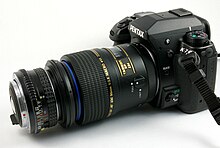Retro position
The retro position is a technique in macro photography in which the lens - usually with the help of a reversing ring (also called retro ring or retro adapter ) - is mounted on the camera in an inverted position so that, instead of its bayonet , its filter thread points towards the camera. The lens is then sometimes referred to as a retro lens .
This time, since the distance of the lens to the film / sensor similar to that of intermediate rings or a bellows is extended, there occurs a similar effect magnifier. The focussing distance is reduced and close-ups are very inexpensive with this technique. Normal lenses are best . Wide-angle lenses allow greater magnification with the same extension, the use of telephoto lenses does not make sense. With image scales above 1: 1, a better image quality is achieved in the retro position with asymmetrically constructed lenses compared to normal assembly.
Similarly, two lenses can be joined together at their respective filter threads with the aid of a coupling ring. In this case, the second lens, placed in front of it, works optically as a close-up lens .
functionality
The focal point or the focal plane in an objective is, for technical reasons, closer to the rear lens than to the front lens. This is so because the film or sensor plane is usually closer to the lens. When focusing a lens, in the normal position, the plane of focus is shifted until it is at the desired distance. Then you have "focused".
If you now use a lens in the retro position, you can image an object that is now in the focal plane of the sensor larger because it is closer to the current front lens. In this case, it is usually qualitatively better to rotate the lens, since the correction calculations were calculated for a minimum distance of 35 to 50 cm and the distortions or aberrations would be greater in the normal position of the lens than in the retro position.
When using close-up lenses, further glass elements are inserted into the light path. This can worsen the picture. The retro ring has an advantage here, as no further glass elements are inserted into the light path. However, with a retroring alone you are not so flexible with the reproduction scale. This can only be varied in connection with a bellows device or intermediate rings. This can be easily changed with different close-up lenses.
Lenses used
Normal lenses , telephoto lenses and wide-angle lenses differ mainly in their angle of view . This is largely due to the focal length. Since the previous recording angle of the lens is now pointing to the film or sensor, the object is displayed correspondingly larger or smaller at this point. The last lens of these lenses is also closer to the film or sensor plane in the case of wide-angle lenses than in the case of telephoto lenses. Therefore, the subject is further away from the lens with telephoto lenses than with wide-angle lenses. For both reasons, the result is that the object can be displayed larger with a wide-angle lens than with a telephoto lens. Therefore you get a larger image scale with a wide-angle lens than with a normal lens. The following gradation can be determined in this regard:
Wide angle lens> normal lens> telephoto lens
In practice, older lenses are often used in a retro position, as they still allowed manual aperture adjustment, in contrast to modern digital lenses, where aperture adjustment is only possible using the camera software.
Use of bellows device / intermediate rings
Normally, a retro ring is not used alone, but is used in combination with intermediate rings or a bellows device to give the lens to the camera a fixed or adjustable distance, i.e. the correct image distance for the intended shooting scale. These devices increase the area on the film or sensor level when the lens is pushed away from the camera. As a result, the image of the object on the film or sensor level is enlarged. In retrospect, this now has the consequence that this area increases more than would be the case in the normal position. Therefore, with a lens in the retro position and on a bellows device / intermediate ring, you can get much larger image scales than in the normal position.
particularities

Fixing the lens by hand is very cumbersome. In the case of reversing rings, which only allow the lens to be attached to the camera, autofocus and automatic aperture functions ( spring aperture ) are not possible and the exposure time must be determined by measuring the working aperture . For camera systems that transfer all lens functions electrically, adapter rings are also available, with which the electrical system is routed to the lens connection via a cable. This means that auto focus and stopping down are also possible as usual. For other lens systems there are special rings which are placed on the free-standing housing connection of the lens and which, for For example, the spring diaphragm function is mechanically transferred to the lens using a special “double wire release”.
Because of the large image scales
- often limited brightness (often the lens itself still shadows)
- and the delicate focusing at close range (and in the creation of the depth of field )
It is often advisable to assemble the camera, bellows device, retro ring and lens on a tripod .
Web links
- Practice and theory of retroposition; Basic article with effects on image scales, distances, exposure, depth of field, etc. online (PDF 2.2 MB; source: fachliteratur.scheibel.de)
Individual evidence
- ↑ ( page no longer available , search in web archives )



